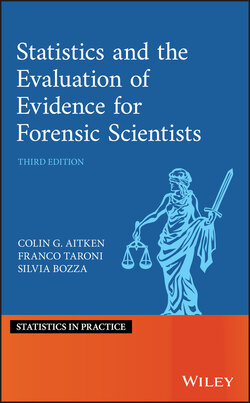Читать книгу Statistics and the Evaluation of Evidence for Forensic Scientists - Franco Taroni - Страница 34
First Law of Probability
ОглавлениеProbability can take any value between 0 and 1, inclusive, and only one of those values. Let be any event and let denote the probability that occurs. Then . For an event that is known to be impossible, the probability is zero. Thus if is impossible, . For an event that is known to be certain, the probability is one. Thus, if is certain, . This law is sometimes known as the convexity rule (Lindley 1991).
Consider the hypothetical example of the balls in the urn of which a proportion are black and a proportion white, with no other colours present, such that . Proportions lie between 0 and 1; hence . For any event . Consider , the drawing of a black ball. If there are no black balls in the urn, this event is impossible then . This law is sometimes strengthened to say that a probability can only be 0 when the associated event is known to be impossible.
The first law concerns only one event. The next two laws, sometimes known as the second and third laws of probability, are concerned with combinations of events. Events combine in two ways. Let and be two events. One form of combination is to consider the event ‘ and ’, the event that occurs if and only if and both occur, sometimes denoted . This is known as the conjunction of and .
Consider the roll of a six‐sided fair die. Let denote the throwing of an odd number. Let denote the throwing of a number greater than 3 (i.e. a 4, 5, or 6). Then the event ‘ and ’ denotes the throwing of a 5.
Secondly, consider rolling two six‐sided fair die. Let denote the throwing of a six with the first die. Let denote the throwing of a six with the second die. Then the event ‘ and ’ denotes the throwing of a double 6.
The second form of combination is to consider the event ‘ or ’, the event that occurs if or (or both) occurs. This is known as the disjunction of and .
Consider again the roll of a single six‐sided fair die. Let , the throwing of an odd number (1, 3, or 5), and , the throwing of a number greater than 3 (4, 5, or 6), be as before. Then ‘ or ’ denotes the throwing of any number other than a 2 (which is both even and less than 3).
Secondly, consider drawing a card from a well‐shuffled pack of 52 playing cards, such that each card is equally likely to be drawn. Let denote the event that the card drawn is a spade. Let denote the event that the card drawn is a club. Then the event ‘ or ’ is the event that the card drawn is from a black suit.
